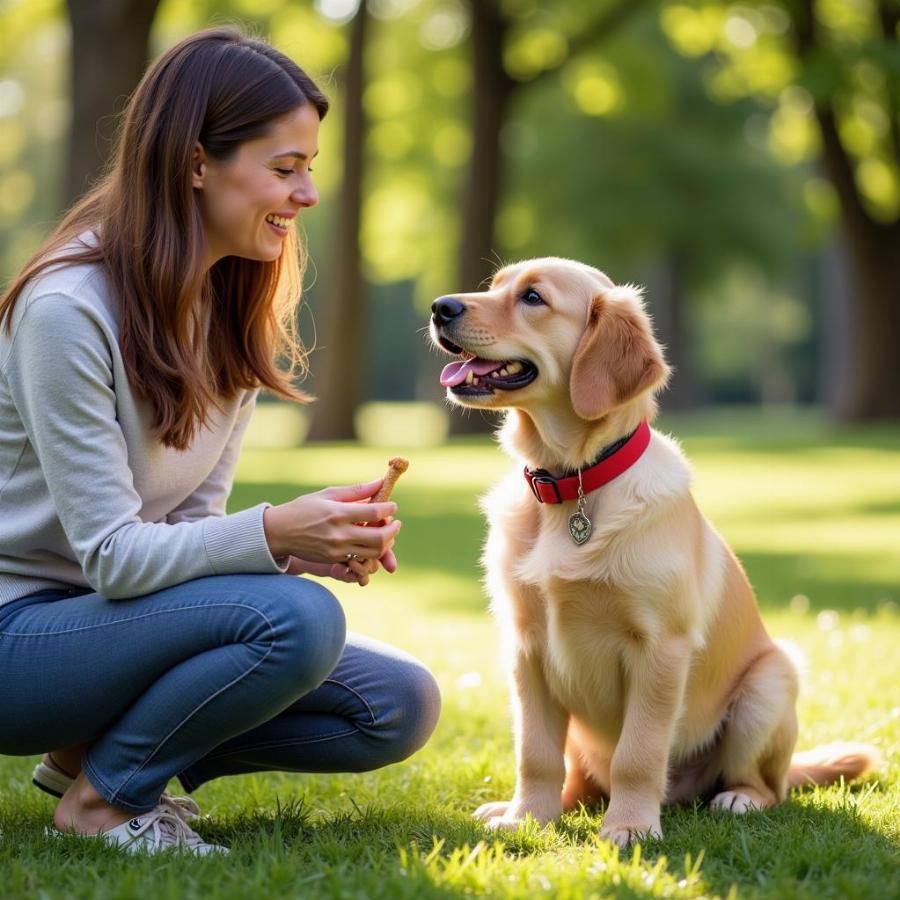The German command for “sit”— “Sitz” (pronounced “zits”)—opens up a world of possibilities for training your canine companion. Whether you’re a seasoned dog owner or just starting out, understanding how to effectively teach your dog “sit in german dog command” can be incredibly rewarding. This article delves into the nuances of teaching this command, from understanding its pronunciation to incorporating it into your daily training routine.
Why Teach Your Dog “Sitz”?
Teaching your dog “Sitz” is more than just a fun party trick; it’s a fundamental command that forms the bedrock of obedience training. “Sitz” offers control in various situations, promoting safety and good behavior. Imagine being able to confidently command your dog to sit before crossing a busy street or greeting guests. This command also serves as a stepping stone for more complex tricks and behaviors.
 Dog learning sit command in German
Dog learning sit command in German
Pronunciation Perfection: How to Say “Sitz” Correctly
Correct pronunciation is crucial for effective communication with your dog. “Sitz” isn’t pronounced like “sits” in English. Instead, the “i” is pronounced like the “i” in “bit”, and the “tz” creates a sharp “ts” sound. Think of the word “fits” but with a “z” sound instead of an “f”. Practice saying it out loud until you’re comfortable with the pronunciation.
Step-by-Step Guide to Teaching “Sitz”
Here’s a breakdown of how to teach your dog the “Sitz” command:
- Lure with a Treat: Hold a treat in your hand, close to your dog’s nose.
- Move the Treat Up and Back: Slowly move the treat over your dog’s head, towards their tail. As their nose follows the treat, their rear end will naturally lower into a sitting position.
- Say “Sitz”: As your dog’s rear touches the ground, clearly say “Sitz”.
- Reward and Praise: Immediately give your dog the treat and offer enthusiastic praise.
- Repetition is Key: Repeat these steps multiple times, keeping the training sessions short and positive.
Troubleshooting Common “Sitz” Challenges
What if your dog doesn’t sit? Don’t get discouraged! Here are some common challenges and solutions:
- Dog stands up: Ensure the treat is positioned correctly to encourage the sitting position. Start by practicing against a wall to help your dog maintain balance.
- Dog jumps up: Avoid holding the treat too high, which can encourage jumping. Keep the treat close to your dog’s nose and move it slowly.
- Dog gets distracted: Choose a quiet training environment with minimal distractions.
Integrating “Sitz” into Daily Life
Once your dog reliably responds to “Sitz”, incorporate it into your daily routine. Ask your dog to “Sitz” before mealtimes, walks, or when greeting people. This reinforces the command and makes it a natural part of their behavior.
Why “Sitz” Matters for Guard Dogs
Even for guard dogs, knowing the “Sitz” command is important for control and focus. While their primary role is protection, having a solid foundation of basic obedience, including guard dogs incitement crossword, is essential.
From “Sitz” to Other Commands
Mastering “Sitz” opens the door to learning other German commands. You might consider teaching your dog “Platz” (down) or “Bleib” (stay) next. Building a repertoire of commands strengthens your bond and enhances communication. You might even be interested in finding some dog names that start with k to go with your new training regime.
Conclusion: Unlocking the Power of “Sitz”
Teaching your dog “sit in german dog command” (“Sitz”) is a rewarding experience that strengthens your bond and enhances communication. By following these simple steps and practicing regularly, you’ll lay a strong foundation for obedience training and empower your dog to navigate the world with confidence and good manners.
FAQ: Your “Sitz” Questions Answered
- Q: How long does it take to teach a dog “Sitz”? A: It varies depending on the dog, but with consistent training, most dogs can learn “Sitz” within a few days or weeks.
- Q: What if my dog already knows “sit” in English? A: You can still teach them “Sitz”! Treat it as a new command, and they’ll learn to associate the different word with the same action.
- Q: Can I use hand signals with “Sitz”? A: Absolutely! Pairing a hand signal with the verbal command can be helpful.
- Q: My dog only sits when I have a treat. How do I fade the lure? A: Gradually reduce your reliance on treats by rewarding intermittently.
- Q: Should I use a clicker when training “Sitz”? A: A clicker can be a useful tool for marking the desired behavior.
More Questions? Explore Beaut Dogs!
Looking for more training tips or information on specific breeds like big black dogs with pointy ears? Check out other articles on our website. Maybe you’re interested in finding some great hunting dog names male for your hunting companion.
Beaut Dogs is your comprehensive resource for all things dog-related. We’re passionate about providing expert advice and valuable insights to help you navigate the wonderful world of dog ownership. For personalized support and answers to your specific questions, please don’t hesitate to contact us via Email: [email protected]. We’re here to help you and your canine companion thrive!